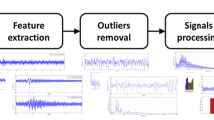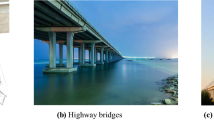Abstract
Environmental variability is a major challenging issue in bridge health monitoring because bridges are more prone to such variability than other civil structures. To deal with this challenge, this article proposes a new machine-learning method for early damage detection under environmental variability by means of the k-medoids clustering, a new damage indicator, and an innovative approach for selecting a proper cluster number. Estimation of a reliable alarming threshold is another important challenge for early damage detection via most of the machine-learning methods. On this basis, a novel probabilistic approach using the theory of extreme value and a goodness-of-fit measure is proposed to estimate an alarming threshold. The major contributions of this article include proposing a new damage indicator suitable for decision making by clustering-based algorithms, an innovative cluster selection algorithm for dealing with the problem of environmental variability and increasing damage detectability, and a novel probabilistic method for threshold estimation. Modal-based features of the well-known Z24 Bridge are considered to verify the accuracy and effectiveness of the proposed approaches along with several comparative studies. Results show that the methods presented here are highly able to detect early damage even under strong environmental variations and estimate a reliable threshold.











Similar content being viewed by others
References
Karbhari VM, Ansari F (2009) Structural health monitoring of civil infrastructure systems. Elsevier, London
Brownjohn JM, De Stefano A, Xu Y-L, Wenzel H, Aktan AE (2011) Vibration-based monitoring of civil infrastructure: challenges and successes. J Civ Struct Health Monit 1(3–4):79–95
Li H-N, Ren L, Jia Z-G, Yi T-H, Li D-S (2016) State-of-the-art in structural health monitoring of large and complex civil infrastructures. J Civ Struct Health Monit 6(1):3–16. https://doi.org/10.1007/s13349-015-0108-9
Li H, Ou J (2016) The state of the art in structural health monitoring of cable-stayed bridges. J Civ Struct Health Monit 6(1):43–67
An Y, Chatzi E, Sim S-H, Laflamme S, Blachowski B, Ou J (2019) Recent progress and future trends on damage identification methods for bridge structures. Struct Contr Health Monit 26(10):e2416. https://doi.org/10.1002/stc.2416
Ye S, Lai X, Bartoli I, Aktan AE (2020) Technology for condition and performance evaluation of highway bridges. J Civ Struct Health Monit 10(4):573–594. https://doi.org/10.1007/s13349-020-00403-6
Xu Y, Brownjohn JMW (2018) Review of machine-vision based methodologies for displacement measurement in civil structures. J Civ Struct Health Monit 8(1):91–110. https://doi.org/10.1007/s13349-017-0261-4
Dorafshan S, Maguire M (2018) Bridge inspection: human performance, unmanned aerial systems and automation. J Civ Struct Health Monit 8(3):443–476. https://doi.org/10.1007/s13349-018-0285-4
Avci O, Abdeljaber O, Kiranyaz S, Hussein M, Gabbouj M, Inman DJ (2021) A review of vibration-based damage detection in civil structures: from traditional methods to Machine Learning and Deep Learning applications. Mech Syst Sig Process 147:107077. https://doi.org/10.1016/j.ymssp.2020.107077
Entezami A, Sarmadi H, Behkamal B, Mariani S (2020) Big data analytics and structural health monitoring: a statistical pattern recognition-based approach. Sensors 20(8):2328. https://doi.org/10.3390/s20082328
Wang ML, Lynch JP, Sohn H (2014) Sensor technologies for civil infrastructures: applications in structural health monitoring. Woodhead Publishing (Elsevier), Cambridge
Wu ZY, Zhou K, Shenton HW, Chajes MJ (2019) Development of sensor placement optimization tool and application to large-span cable-stayed bridge. J Civ Struct Health Monit 9(1):77–90. https://doi.org/10.1007/s13349-018-0320-5
Amezquita-Sanchez JP, Adeli H (2016) Signal processing techniques for vibration-based health monitoring of smart structures. Arch Comput Methods Eng 23(1):1–15. https://doi.org/10.1007/s11831-014-9135-7
Flah M, Nunez I, Ben Chaabene W, Nehdi ML (2020) Machine learning algorithms in civil structural health monitoring: a systematic review. Arch Comput Methods Eng. https://doi.org/10.1007/s11831-020-09471-9
Azimi M, Eslamlou AD, Pekcan G (2020) Data-driven structural health monitoring and damage detection through deep learning: state-of-the-art review. Sensors 20(10):2778
Sarmadi H, Karamodin A (2020) A novel anomaly detection method based on adaptive Mahalanobis-squared distance and one-class kNN rule for structural health monitoring under environmental effects. Mech Syst Sig Process 140:106495. https://doi.org/10.1016/j.ymssp.2019.106495
Nazarian E, Taylor T, Weifeng T, Ansari F (2018) Machine-learning-based approach for post event assessment of damage in a turn-of-the-century building structure. J Civ Struct Health Monit 8(2):237–251. https://doi.org/10.1007/s13349-018-0275-6
Sarmadi H, Entezami A (2021) Application of supervised learning to validation of damage detection. Arch Appl Mech 91(1):393–410. https://doi.org/10.1007/s00419-020-01779-z
Sarmadi H, Entezami A, Saeedi Razavi B, Yuen K-V (2021) Ensemble learning-based structural health monitoring by Mahalanobis distance metrics. Struct Contr Health Monit 28(2):e2663. https://doi.org/10.1002/stc.2663
Daneshvar MH, Gharighoran A, Zareei SA, Karamodin A (2020) Early damage detection under massive data via innovative hybrid methods: application to a large-scale cable-stayed bridge. Struct Infrastruct Eng. https://doi.org/10.1080/15732479.2020.1777572
Entezami A, Sarmadi H, Mariani S (2020) An unsupervised learning approach for early damage detection by time series analysis and deep neural network to deal with output-only (big) data. Eng Proc 2(1):17. https://doi.org/10.3390/ecsa-7-08281
Xia Y, Chen B, Weng S, Ni Y-Q, Xu Y-L (2012) Temperature effect on vibration properties of civil structures: a literature review and case studies. J Civ Struct Health Monit 2(1):29–46. https://doi.org/10.1007/s13349-011-0015-7
Han Q, Ma Q, Xu J, Liu M (2020) Structural health monitoring research under varying temperature condition: a review. J Civ Struct Health Monit. https://doi.org/10.1007/s13349-020-00444-x
Mu H-Q, Yuen K-V (2018) Modal frequency-environmental condition relation development using long-term structural health monitoring measurement: uncertainty quantification, sparse feature selection and multivariate prediction. Meas 130:384–397
Sohn H (2007) Effects of environmental and operational variability on structural health monitoring. Philos Trans Royal Soc A 365(1851):539–560
Santos JP, Crémona C, Calado L, Silveira P, Orcesi AD (2016) On-line unsupervised detection of early damage. Struct Contr Health Monit 23(7):1047–1069
Diez A, Khoa NLD, Alamdari MM, Wang Y, Chen F, Runcie P (2016) A clustering approach for structural health monitoring on bridges. J Civ Struct Health Monit 6(3):429–445
de Almeida CR, Cury A, Barbosa F (2019) Automated real-time damage detection strategy using raw dynamic measurements. Eng Struct 196:109364. https://doi.org/10.1016/j.engstruct.2019.109364
Entezami A, Sarmadi H, Saeedi Razavi B (2020) An innovative hybrid strategy for structural health monitoring by modal flexibility and clustering methods. J Civ Struct Health Monit 10(5):845–859. https://doi.org/10.1007/s13349-020-00421-4
da Silva S, Junior MD, Junior VL, Brennan MJ (2008) Structural damage detection by fuzzy clustering. Mech Syst Sig Process 22(7):1636–1649
Figueiredo E, Cross E (2013) Linear approaches to modeling nonlinearities in long-term monitoring of bridges. J Civ Struct Health Monit 3(3):187–194
Yang C, Liu Y, Sun Y (2016) Damage detection of bridges considering environmental temperature effect by using cluster analysis. Procedia Engineering 161:577–582. https://doi.org/10.1016/j.proeng.2016.08.695
Coles S, Bawa J, Trenner L, Dorazio P (2001) An introduction to statistical modeling of extreme values, vol 208. Springer, Berlin
Salvadori G, De Michele C, Kottegoda NT, Rosso R (2007) Extremes in nature: an approach using copulas, vol 56. Springer Science and Business Media, Berlin
Deraemaeker A, Worden K (2018) A comparison of linear approaches to filter out environmental effects in structural health monitoring. Mech Syst Sig Process 105:1–15. https://doi.org/10.1016/j.ymssp.2017.11.045
Wu J (2012) Advances in k-means clustering: a data mining thinking. Springer Science and Business Media, Heidelberg
Gan G, Ma C, Wu J (2007) Data clustering: theory, algorithms, and applications, vol 20. University City, Siam
Aggarwal CC, Reddy CK (2016) Data clustering: algorithms and applications. CRC Press, Boca Raton
Weller-Fahy DJ, Borghetti BJ, Sodemann AA (2014) A survey of distance and similarity measures used within network intrusion anomaly detection. IEEE Commun Surv Tutor 17(1):70–91
Deza MM, Deza E (2014) Encyclopedia of distances, 3rd edn. Springer, Heidelberg
Abello J, Pardalos PM, Resende MGC (2013) Handbook of massive data sets. Springer US, New York
Rébillat M, Hmad O, Kadri F, Mechbal N (2018) Peaks over threshold-based detector design for structural health monitoring: application to aerospace structures. Struct Health Monit 17(1):91–107. https://doi.org/10.1177/1475921716685039
Krit M, Gaudoin O, Remy E (2019) Goodness-of-fit tests for the Weibull and extreme value distributions: a review and comparative study. Commun Stat Simul Comput. https://doi.org/10.1080/03610918.2019.1594292
Perez-Rodriguez P, Vaquera-Huerta H, Villaseñor-Alva JA (2009) A goodness-of-fit test for the gumbel distribution based on Kullback–Leibler information. Commun Stat Theory Methods 38(6):842–855
Maeck J, De Roeck G (2003) Description of Z24 Bridge. Mech Syst Sig Process 17(1):127–131. https://doi.org/10.1006/mssp.2002.1548
Author information
Authors and Affiliations
Corresponding author
Ethics declarations
Conflict of interest
The authors declare that they have no conflict of interest.
Additional information
Publisher's Note
Springer Nature remains neutral with regard to jurisdictional claims in published maps and institutional affiliations.
Rights and permissions
About this article
Cite this article
Sarmadi, H., Entezami, A., Salar, M. et al. Bridge health monitoring in environmental variability by new clustering and threshold estimation methods. J Civil Struct Health Monit 11, 629–644 (2021). https://doi.org/10.1007/s13349-021-00472-1
Received:
Revised:
Accepted:
Published:
Issue Date:
DOI: https://doi.org/10.1007/s13349-021-00472-1




